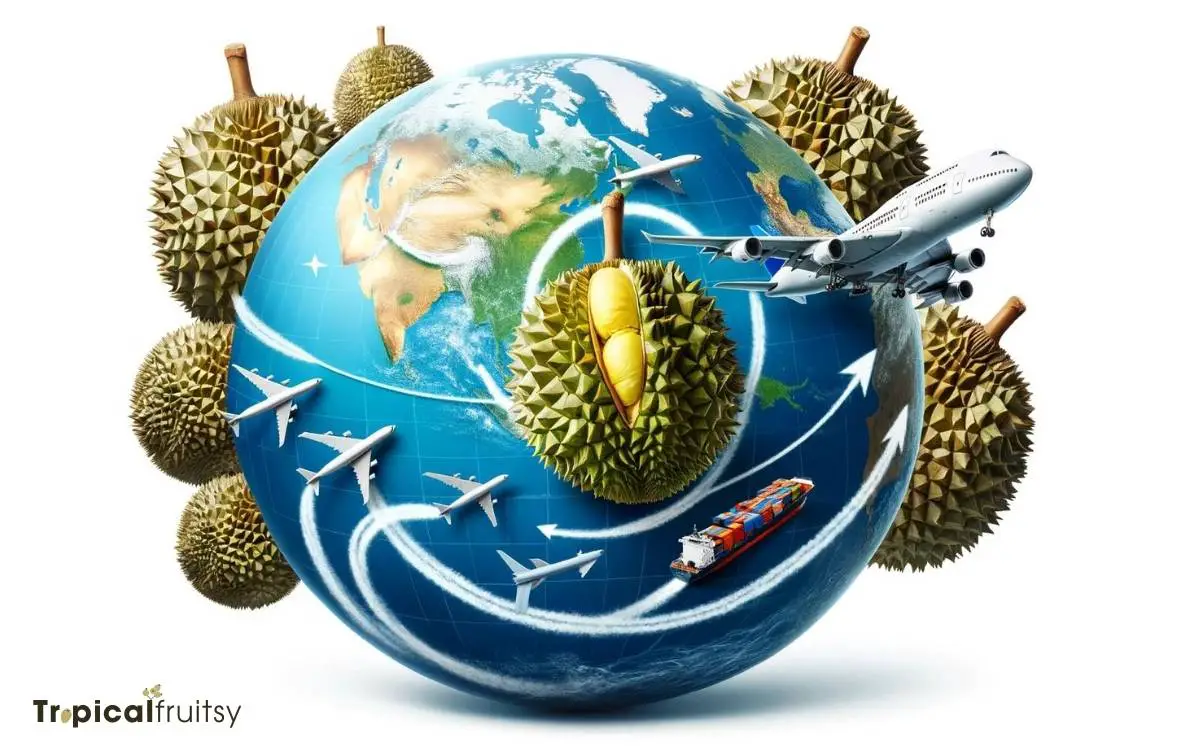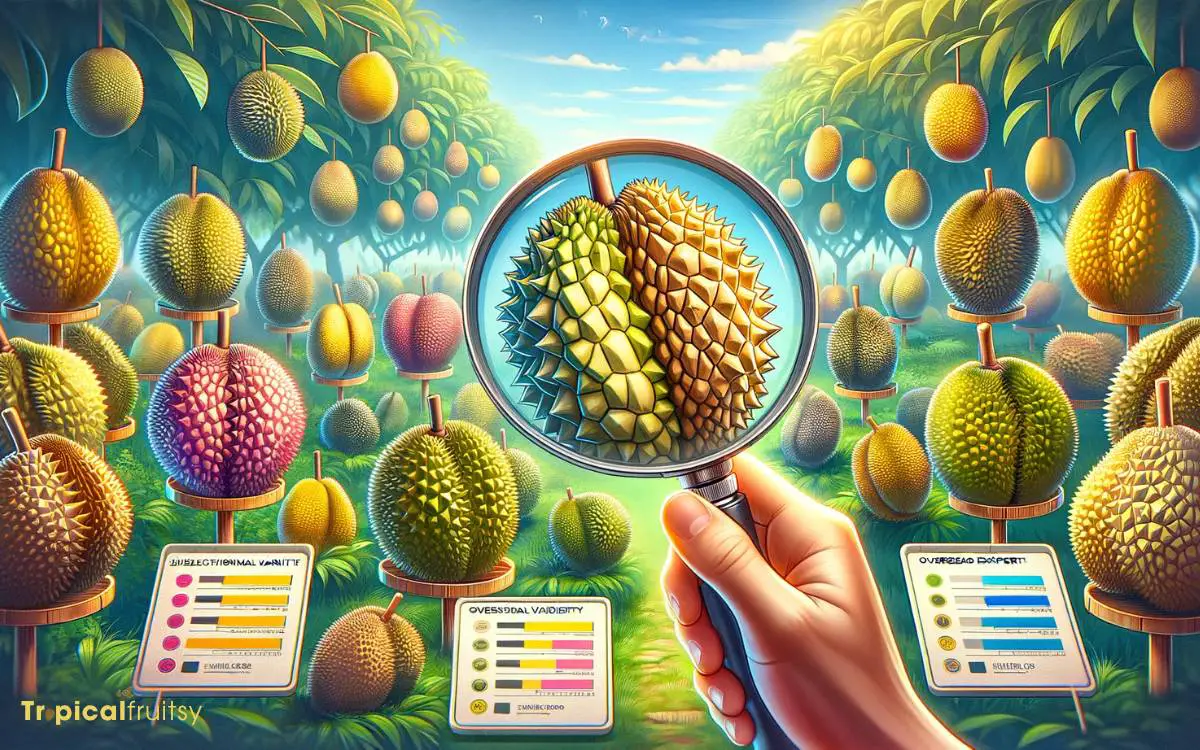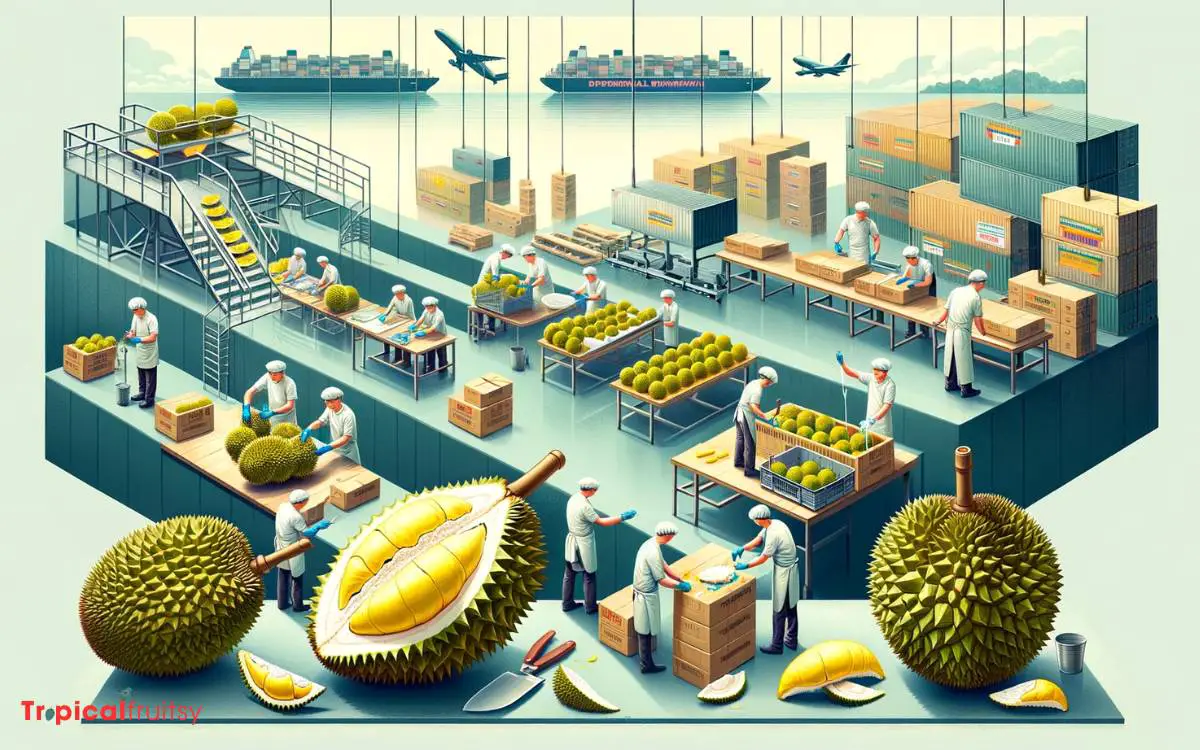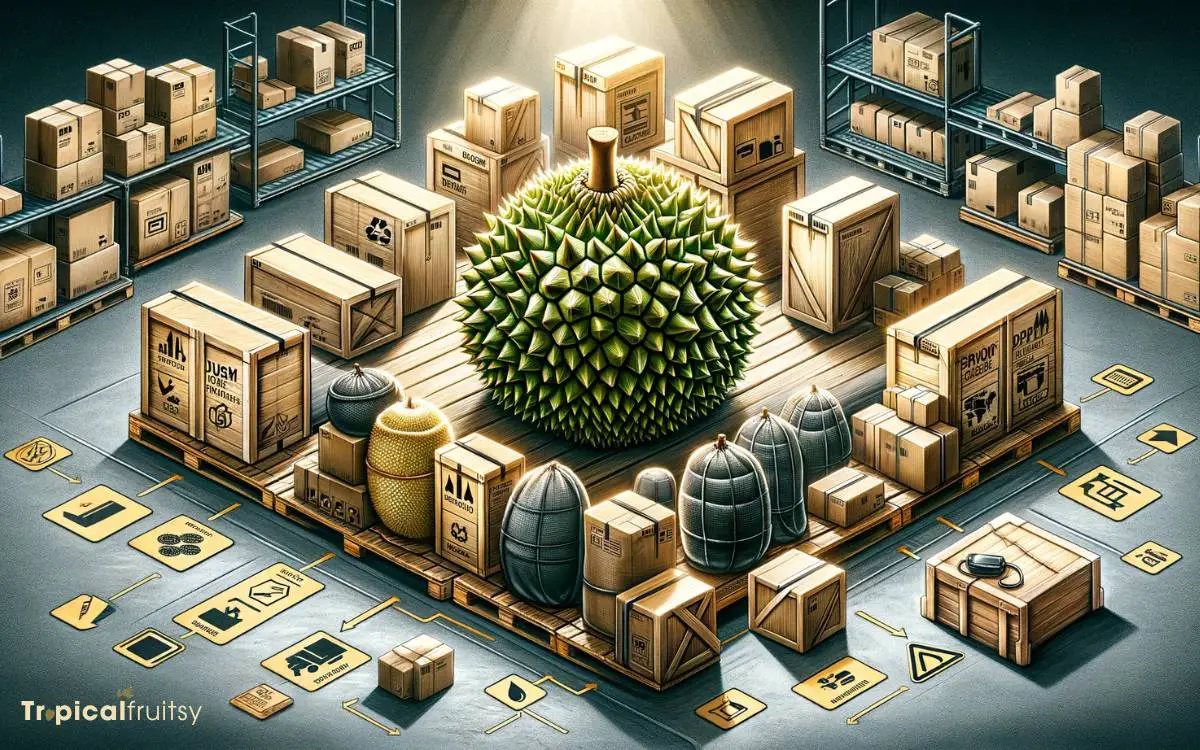How to Send Durian Overseas? 5 Easy Steps!
The transportation of durian, a fruit revered for its distinctive taste and aroma, overseas is a process that demands meticulous planning and adherence to regulatory standards.
This guide is designed to assist exporters and individuals in understanding the complexities involved in the international shipping of durian.
It outlines the critical steps, from comprehending export regulations and selecting the appropriate durian variety to ensuring proper packaging and navigating customs procedures.
Each phase is crucial to maintaining the fruit’s quality and ensuring compliance with the import policies of the destination country.
By addressing these considerations and choosing a reliable freight service, one can successfully send durian overseas while mitigating the risks of spoilage or regulatory non-compliance.

Key Takeaway
Understanding Durian Export Regulations

Before attempting to send durian overseas, it is imperative to familiarize oneself with the specific export regulations and restrictions that vary by destination country.
The pertinent legal frameworks encompass agricultural standards, phytosanitary requirements, and food safety protocols that are designed to mitigate the introduction of pests and diseases, ensure product quality, and protect public health.
Compliance with such regulations is mandatory and necessitates obtaining appropriate certifications and clearances from domestic and foreign authorities.
It is crucial to engage with the International Plant Protection Convention (IPPC) guidelines and secure a phytosanitary certificate, which validates that the durian shipment has been inspected and is free from quarantine pests, conforming to the importing country’s statutory requirements.
Failure to adhere to these stringent protocols may result in the rejection of the shipment at the destination port, financial losses, and potential legal ramifications.
Step 1: Selecting the Right Durian Variety

When planning to send durian overseas, it is essential to zero in on a variety suited to the tastes and regulations of the destination market.
The selection process involves a comprehensive assessment of durian cultivars, considering the following:
- Sensory Attributes
- Flavor profile: sweet, bitter, or a balance of both
- Texture: creamy, custard-like, or firmer
- Transportability
- Shelf-life: longer for distant markets
- Robustness: resistance to physical damage during shipping
Each variety possesses unique characteristics that must align with the import country’s consumer preferences and import criteria.
For instance, the Musang King is renowned for its creamy texture and sweet taste, making it a popular export choice.
However, thorough compliance checks for phytosanitary standards are imperative to ensure successful entry into the target market.
Step 2: Preparing Durian for Packaging

Subsequently, ensuring the durian is meticulously prepared for packaging becomes a crucial step in maintaining its quality during transit.
Prior to packaging, the durian must undergo a thorough inspection to ensure that it meets the phytosanitary requirements of the destination country. This involves removing any soil, pests, or extraneous material that could pose a risk to foreign ecosystems.
The fruit should be at the correct stage of ripeness to prevent overripening during shipment. Temperature control is paramount; durians must be kept at approximately 12°C to 22°C to preserve freshness.
The use of food-safe, breathable materials for wrapping is recommended to prevent condensation and mold growth. Each fruit should be individually wrapped and cushioned to minimize physical damage.
Adherence to these protocols is essential for successful international shipping.
Step 3: Choosing Appropriate Packaging Materials

How, then, should one select the optimal packaging materials to ensure the durian’s integrity during its international journey?
The selection process must be guided by technical specifications, regulatory compliance, and the material’s capacity to protect the fruit’s sensory and physical qualities.
Primary Packaging:
Vacuum-sealed bags:
- Preserve aroma and freshness
- Mitigate odor leakage concerns
Secondary Packaging:
Rigid containers:
- Provide structural protection against physical impacts
- Must be of food-grade quality and comply with international shipping standards
Each layer of packaging should synergistically ensure the durian’s preservation from the point of origin to the final destination, taking into consideration temperature fluctuations, humidity control, and potential exposure to contaminants.
Use of desiccants and insulation may be required to maintain the appropriate microclimate within the package.
Step 4: Navigating Customs and Documentation

Ensuring compliance with international customs regulations is paramount when exporting durian fruit.
Exporters must secure and accurately complete all required documentation, including phytosanitary certificates, to meet destination countries’ import restrictions.
A thorough understanding of the clearing customs process is essential to facilitate the smooth transit and delivery of durian shipments across borders.
Required Export Documents
Before you can send durian overseas, you must acquaint yourself with the necessary export documentation and customs regulations to ensure a smooth transaction.
The documentation process is multi-faceted, encompassing various forms and certifications that adhere to both the exporting and importing countries’ legal frameworks.
- Commercial Invoice: Essential for all international shipments, detailing the transaction between seller and buyer.
- Includes: Product description, value, and pertinent trade terms.
- Phytosanitary Certificate: A testament to the durian’s compliance with agricultural standards.
- Issued by: National plant protection organization (NPPO).
- Purpose: To certify that the durian is pest-free and meets the import requirements of the destination country.
Each document serves as a critical checkpoint in the journey of durian exportation, facilitating regulatory clearance and the successful delivery of this exotic fruit to foreign markets.
Import Restrictions
Import restrictions for durian vary by country and require meticulous attention to country-specific customs and documentation procedures.
Stakeholders must be conversant with the phytosanitary regulations that govern the import of agricultural products to prevent the introduction of pests and diseases.
Compliance with these regulations necessitates obtaining a phytosanitary certificate from the exporting country’s agricultural department, which verifies that the durian has been inspected and meets the importing country’s health standards.
Furthermore, importers must be aware of any tariffs, taxes, or trade agreements that may affect the entry of durian into the destination country.
It is imperative to ensure that all documentation is complete, accurate, and presented in the required format to avoid delays or confiscation of the shipment by customs officials.
Clearing Customs Process
The customs clearance process for exporting durian requires thorough preparation and precise documentation to facilitate a smooth transition through international borders.
Key considerations include:
- Compliance with Export and Import Country Regulations:
- Export Declarations: Submission of accurate export data pertaining to the consignment.
- Import Permits: Securing necessary permits from the destination country’s regulatory bodies.
Documentation Requirements:
- Phytosanitary Certificates: Ensuring durians are free from pests and diseases.
- Commercial Invoices: Itemizing the shipment’s value and description.
Adherence to these prerequisites is paramount to negate potential delays or confiscation.
Clear and accurate documentation corroborates the legality and safety of the durian shipment, ensuring it meets both the export and import country’s phytosanitary regulations.
With these considerations addressed, attention must shift to selecting a reliable shipping service.
Step 5: Selecting a Reliable Shipping Service

When exporting durian, the choice of a shipping service must be predicated on an assessment of the carrier’s reputation, ensuring adherence to both international shipping standards and specific regulations pertaining to durian transport.
Evaluating the service speed is critical to minimize transit time, thereby preserving the fruit’s quality and meeting delivery expectations.
Moreover, a shipper must verify the carrier’s proficiency in handling durians, which includes proper packaging and temperature control capabilities, to mitigate the risk of spoilage.
Carrier Reputation Check
Selecting a reputable shipping carrier is crucial for ensuring that durians arrive at their international destinations in optimal condition.
It is essential to conduct a thorough carrier reputation check, which involves:
Assessing historical performance data:
- On-time delivery rates
- Condition of goods upon arrival
- Reviewing regulatory compliance:
- Adherence to international shipping regulations
- Certifications for handling perishable goods
A carrier with a proven track record of reliability and regulatory compliance is indispensable. This ensures not only timely delivery but also the maintenance of durians in a state fit for consumption upon arrival.
When evaluating potential carriers, engage with those who demonstrate technical expertise in perishable logistics and possess a clear understanding of the delicate nature of durian transportation.
Service Speed Evaluation
In choosing a shipping service for durians, evaluating the speed of delivery is paramount, as it directly impacts the fruit’s freshness upon arrival.
Prospective shippers must scrutinize transit times offered by carriers and assess their alignment with the perishability threshold of durians.
Expedited services are advisable, with clear, guaranteed delivery benchmarks and minimal transit stops that could induce spoilage.
Additionally, consideration should be given to the carrier’s ability to facilitate swift customs clearance—a critical speed factor in international shipping.
Select a service that provides transparent tracking capabilities to monitor the shipment’s progress and preempt any delays.
Ultimately, the chosen logistics provider must demonstrate a proven track record of adherence to declared delivery schedules, particularly for perishable commodities.
Durian Handling Expertise
We must ensure that the shipping service we choose has specialized experience in handling durians to maintain the integrity of the fruit during transit.
Proficiency in durian handling includes:
- Temperature Control: Mastery in maintaining optimal temperatures to prevent spoilage.
- Cushioning Techniques: Utilization of protective packaging to safeguard against physical damage.
Regulatory Compliance:
- International Standards: Adherence to global shipping regulations, including those specific to perishable items.
- Customs Expertise: Navigation through customs protocols to minimize delays.
Selecting a carrier with a demonstrable track record in managing these complexities is crucial.
They must offer transparent communication and precise logistical coordination to ensure that the durians arrive at their destination in peak condition, ready for consumption or further distribution.
Conclusion
In the intricate dance of international trade, ensuring the safe passage of durian across borders is akin to a choreographed ballet, requiring precision and adherence to regulatory nuances.
Mastery of export regulations, meticulous selection of durians, careful preparation and packaging, and thorough documentation are the pillars that uphold the seamless transport of this pungent delicacy.
A reliable shipping service serves as the final, pivotal partner in delivering the king of fruits to distant shores without compromising its regal quality.






